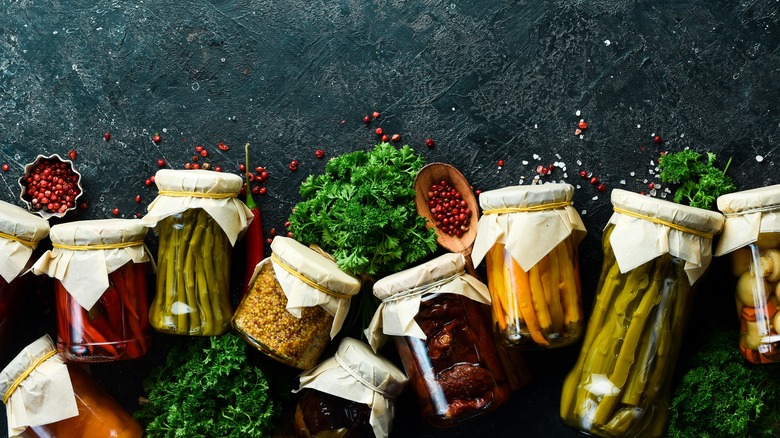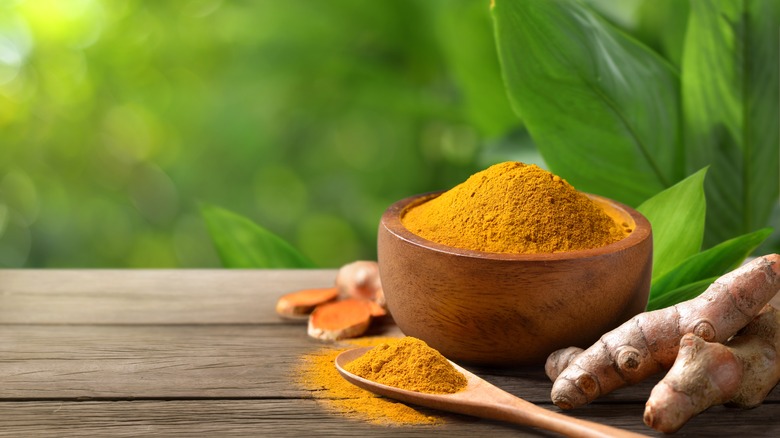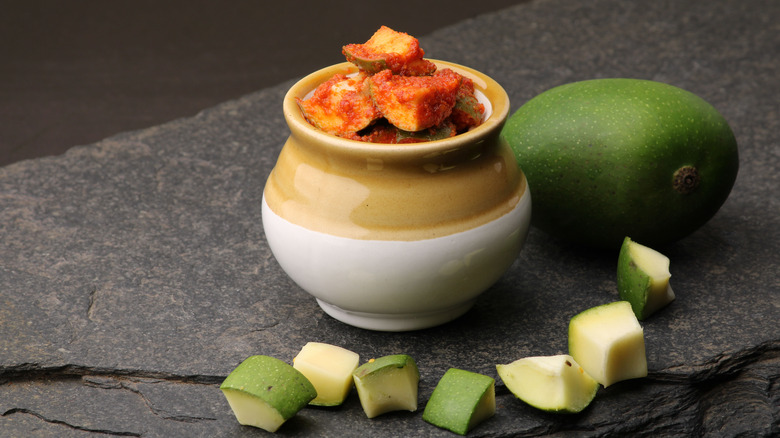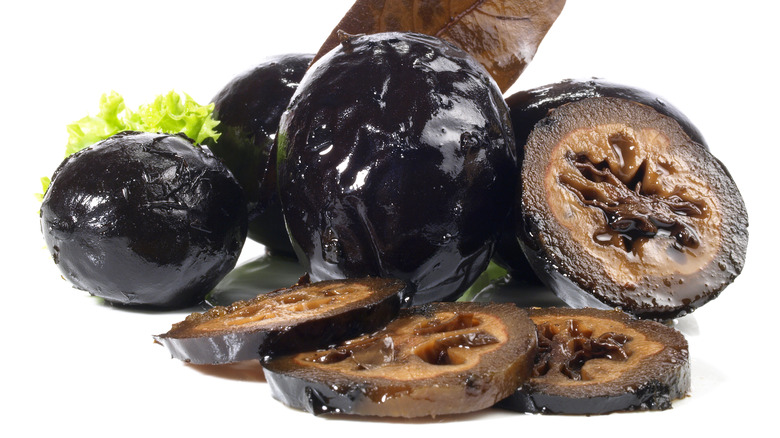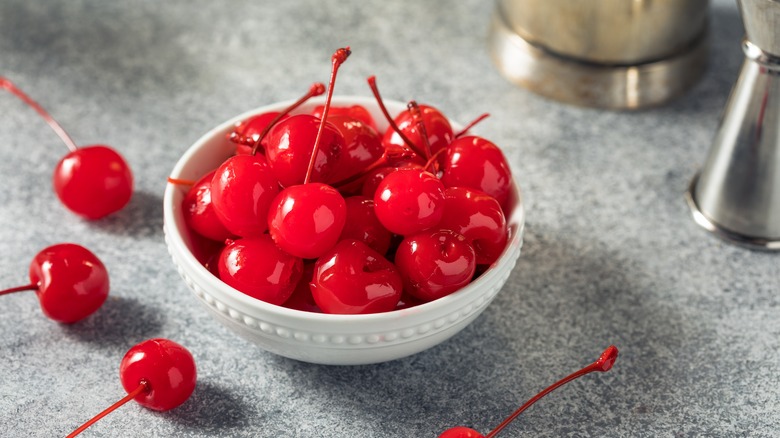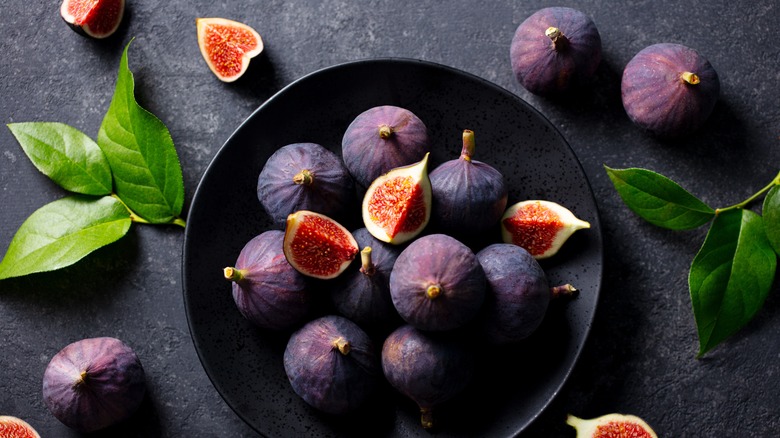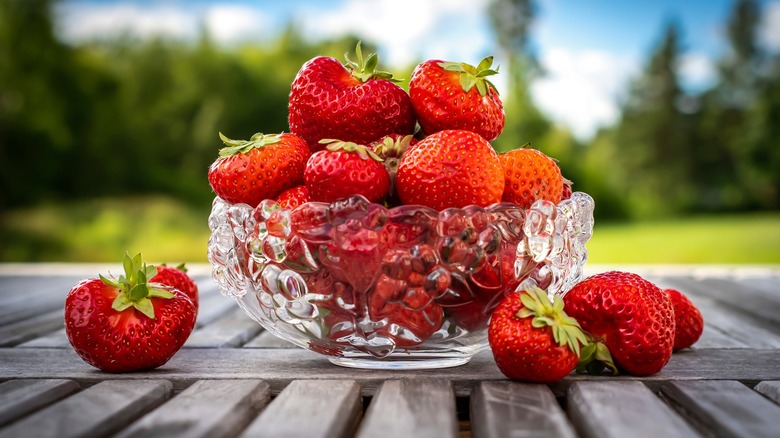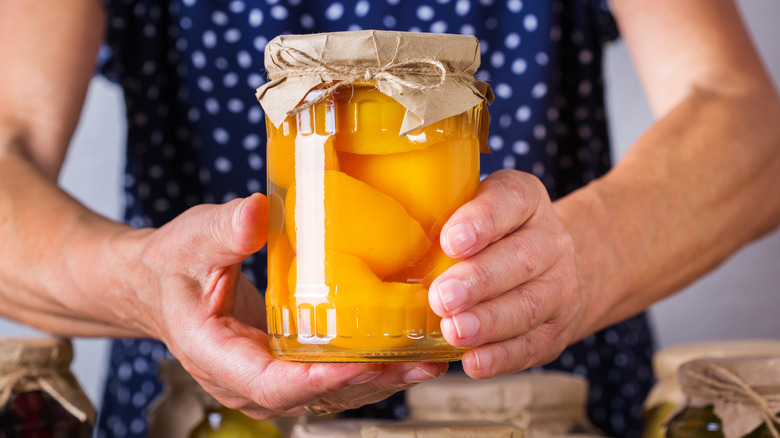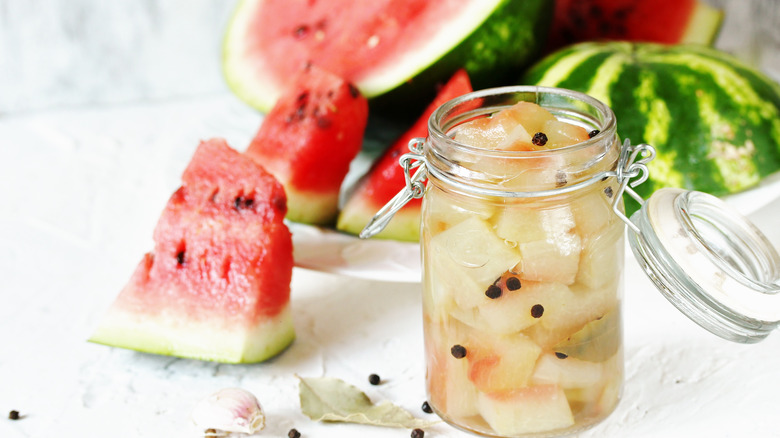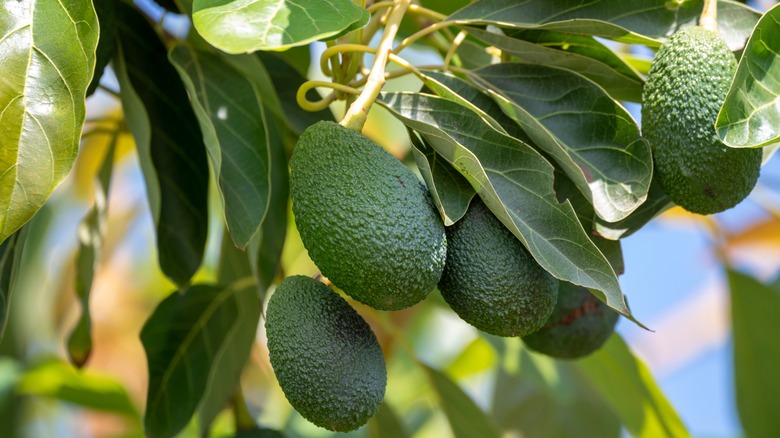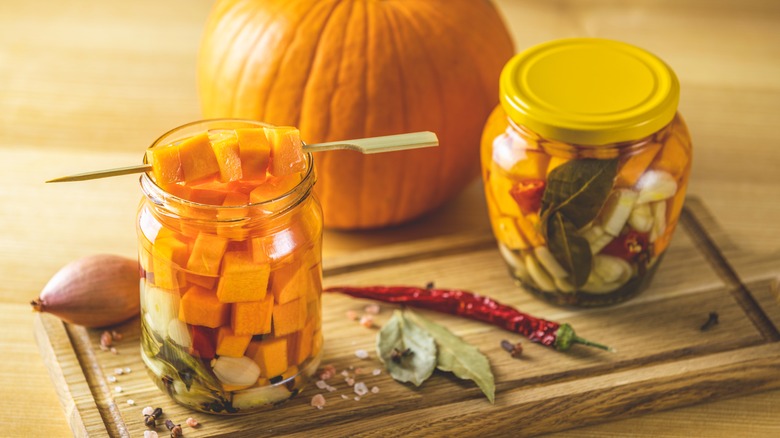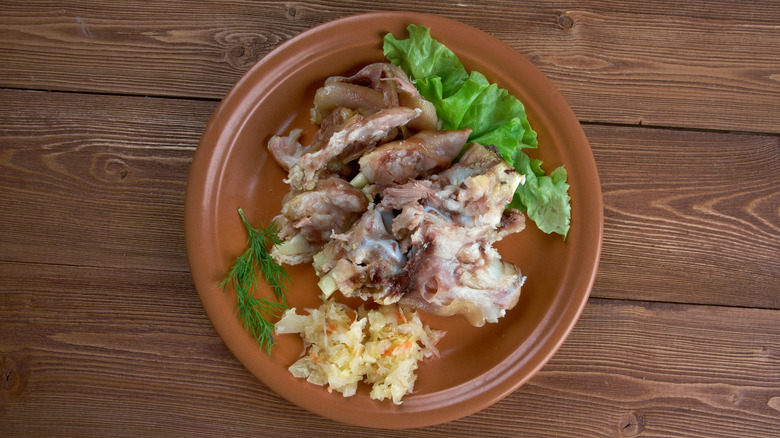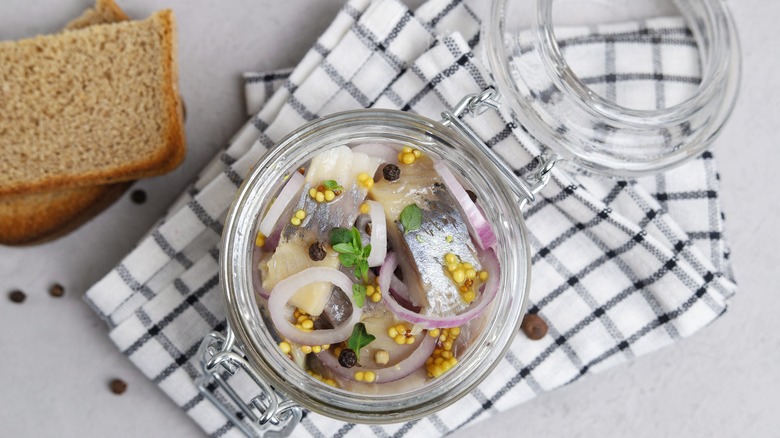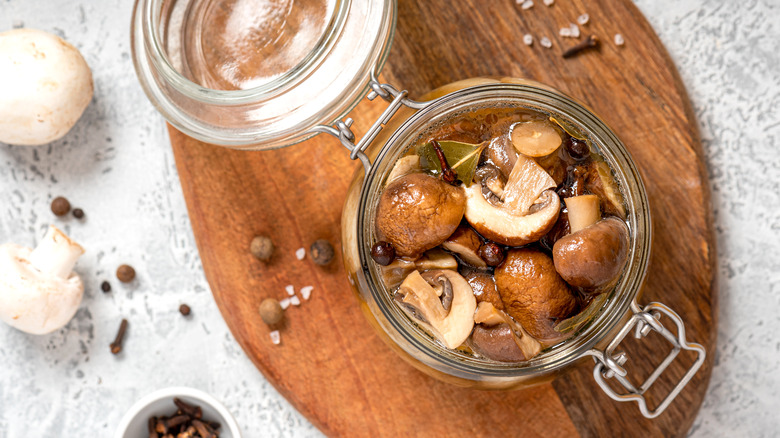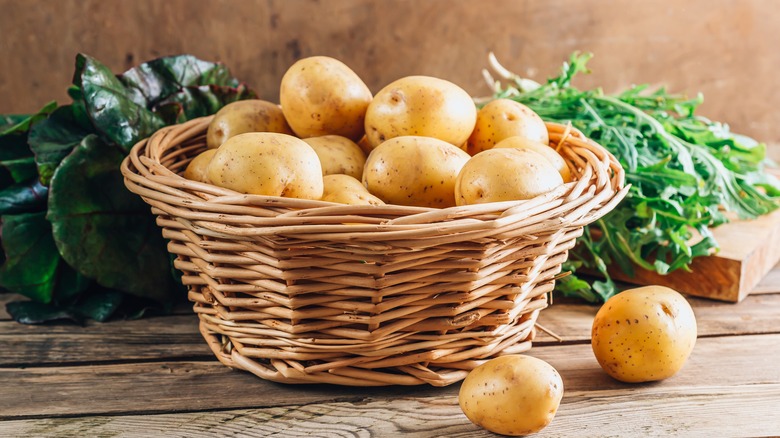14 Surprising Foods You Can Pickle
The best-known pickles are unequivocally the brined cucumbers served in a myriad of delicious ways. However, the world of pickles expands far beyond the classic cukes. Science Direct explains that pickling occurs when food is immersed in an acidic or salty solution to delay spoilage. While not every pickle is fermented, pickling and fermentation do often overlap. Colloquially, the word pickles typically signifies pickled cucumbers, but the term also broadly refers to a variety of products that have undergone the pickling process.
A wide range of produce is pickled in the United States, including vegetables — either individual or mixed, such as giardiniera — as well as red onions, eggs, chiles, and aromatics like garlic and ginger. It's possible to pickle practically any fruit, vegetable, or even animal product, and this food preservation method is found in most cuisines. Simple, yet effective, pickling is one of the oldest methods of food preservation, dating back 4,000 years to the ancient Mesopotamians (via History.com). Pickles of all kinds have since become staples across the globe, renowned for their longevity, taste, and perceived health benefits. While some types of pickles may be familiar, there are plenty of surprising foods that you probably didn't know could be pickled. Thanks to resources such as the National Center for Home Food Preservation, it is quick, easy, and inexpensive to create a variety of pickles at home, bringing their bright, tangy flavors to your favorite dishes and perhaps even leading to some new ones.
Turmeric
Touted for its bold color and purported health benefits, turmeric has become a popular addition to Western cooking, making appearances in everything from vegetables and salad dressings to juices and lattes. The root-like stem has an appearance similar to ginger that can be used whole or ground into the signature golden powder. While it has recently gained traction in America for its notoriety as a superfood, turmeric has been used in culinary, medicinal, and religious practices across the world for thousands of years. The ancient ingredient has a long history in Ayurvedic medicine as an anti-inflammatory as well as a remedy for a host of other maladies (via PBS).
Turmeric also plays a significant role in religious and spiritual rituals across Southern Asia. From ceremonial to skincare, this vibrant ingredient has a long list of applications, including pickling. Turmeric pickle is made using raw, whole turmeric and oil which helps preserve and absorb its nutritional benefits while bypassing the labor-intensive process of making turmeric powder. Pickled turmeric makes a bright, tangy addition to grain bowls, rice, and curries as well as a tasty topping or side dish.
Mangos
Iterations of pickled mango have a significant place in the culinary traditions of India and Hawaii, as well as other Asian and South Pacific cultures. In India, achar is a commonly used condiment, and its mango variety — aam ka achaar, or mango pickle — is packed with bold, aromatic spices and works as a spicy, tangy, and complex accompaniment to rice, eggs, curries, or just about anything. Distinctly different from its sweeter relative mango chutney, mango pickle balances the natural sweetness of the fruit with the savory flavors of mustard seed and chili and is almost always found on the table in Indian households.
If you have ever attended a traditional luau in Hawaii, you have likely come across the island version of pickled mangoes as part of the feast. Distinct from the Indian version, Hawaiian-style pickled mangos are a little sweet and a little sour, using sliced green mangos and sometimes li hing mui — a dried plum powder that is simultaneously salty, sour, and sweet — for extra depth of flavor (via Onolicious Hawaii). The Hawaiian version sometimes carries a red hue from the addition of either food dye or hibiscus flowers. Whether you prefer the bold spice of mango pickle or the sweet and sour balance of Hawaiian pickled mangoes, this surprising pickle should have a place on your table. Try pairing the tangy pickled fruit with rice, grilled meats, vegetables, curries, or a fresh radish slaw to experience all the nuances of this vibrant pickle.
Walnuts
The British have been pickling walnuts for centuries, but the dark, tangy nuts are far less common on this side of the pond. While fresh walnuts are mild in flavor, pickled walnuts have a much bolder taste best balanced with creamy cheeses and rich meats, making them a perfect complement to a cheese or charcuterie board. Pickled walnuts became especially popular in the United Kingdom due to the inability of the nuts to fully ripen in the region's cooler climate. To avoid wasting the crop, the unripe green walnuts were harvested and pickled over a lengthy process.
The Wisconsin Historical Society recreated a recipe for pickled walnuts found in an 1875 issue of the Dodgeville Chronicle that called for nine days of brining followed by five months of pickling. The practice of pickling walnuts can be seen in certain regions across the United States such as parts of the Midwest and Appalachia but is otherwise fairly uncommon outside of the United Kingdom likely due to the arduous process. If you are willing to put in the work and the wait, pickled walnuts are an English delicacy worth a try, and work well as a unique conversation starter to include on your next charcuterie board.
Cherries
Pickled and fermented fruits strike a tantalizing balance between sweet and sour that adds complexity and depth to savory dishes and desserts. While cherries are most often enjoyed in their fresh form or cooked down into jam or pie filling, one distinctive style of cherry led the pickling charge. Maraschino cherries have a boozy origin story that starts all the way in Croatia and leads all the way to their iconic place atop a classic hot fudge sundae.
Travelers who had tasted the preserved cherries in Europe brought them into fashion in the United States by the early 1900s as a popular cocktail garnish largely imported from Italy. At the same time, farmers in Oregon discovered the region offered an ideal climate for growing sweet cherries. but had no reliable method for preserving them as they tended to bruise easily, quickly turning mushy and rotten. According to What's Cooking America, Oregon State University professor Ernest Weigand is credited with developing the method of pickling cherries in brine and adding ingredients to keep them firm before transforming them into maraschinos. The candied treat has now become a popular addition to ice cream, dessert recipes, and fruit salad. Moving away from the sugar-sweetened, brightly dyed maraschino cherries, tangy pickled cherries have begun to appear on restaurant menus, continuing the evolution of the ruby fruit. Use pickled cherries by tossing them into a summer salad, muddling them into a refreshing cocktail, or adding a briny zing to sugary desserts.
Figs
Although fig trees are commonly found growing across the United States, many Americans are not familiar with fresh figs. One of the earliest fruits cultivated by man, figs have a long cultural and culinary history, especially in Mediterranean and Middle Eastern cuisines. With numerous mentions in history, mythology, and religious texts, the nutritious fruit made its way across the world per Nutrition Visual Stories.
In the West, the round fruit with its delicate skin and sweet, jammy center typically peaks around July or August and produces until the first frost (via Pick Your Own). Although the season for enjoying fresh figs in the United States is relatively short, they can also be frozen, candied, turned into jams and preserves, and of course, pickled. Delighted Cooking notes that both fresh and dried figs can be pickled with sugar and spices such as cinnamon, cloves, and allspice often added to the brine. Enjoy pickled figs on their own or as a sweet and tart addition to cocktails, meats, salads, and charcuterie boards. You might even want to try a pickled fig sandwich.
Berries
Fresh berries are a summer icon, but the window of opportunity for savoring juicy strawberries, tart raspberries, and other summer fruit is all too fleeting. To brighten up the cold winter months with a taste of summer, Chef Alex Figura turns to preservation methods such as slowly pickled fruit. Syrupy sugar-soaked berries are combined with a salt and vinegar brine to create a sweet and sour concoction that can be used in a variety of applications. Pickled strawberries can be paired with soft, rich cheeses in bruschetta or on a charcuterie board, while the brining liquid might be whisked into a vinaigrette, marinade, or glaze.
Ferment Works observes pickled green strawberries have also become a trendy ingredient for creative chefs who transform them into chutneys and salsas to serve with everything from seafood to desserts. Strawberries are not the only berry ripe for pickling. With their firm texture, blackberries are also an excellent candidate for the method as they hold up to brining without breaking down into mush (via Funky Foods). If you find yourself with overabundant berry bushes in the peak of summer, consider giving pickled berries a try for an unconventional way to enjoy summer berries all year long.
Peaches
A bushel of peaches can be transformed into a lot more than summer pies thanks to preservation methods like pickling. Researching Food History highlights decades-old recipes for both sweet and savory versions of pickled peaches — the former with sugar and warm spices and the latter with ginger, whole pepper, and mustard seed — that showcase the diversity of the tender stone fruit. Get creative with your fruit pickles by experimenting with different chiles and aromatics as well as sweet and savory spices.
Pickled peaches are easy to make with a variety of methods to choose from, including quick, refrigerator pickles for short-term use and traditionally canned peaches to store in the pantry for later. Sweet pickled peaches make a luxurious topping for ice cream or pound cake and also perfectly complement salty, cured meats and crispy fried chicken. Beyond cheese platters and chicken and waffles, pickled peaches have appeared as a trendy ingredient for cocktails in bars across the country, from Colorado to New York City.
Rinds, peels, and stems
The UN Environment Programme reports that one-third of the food produced in the world — about 1.3 billion tons — is wasted every year. The United States is one of the largest offenders, annually sending an estimated 133 billion pounds of edible food to the landfill. Methods of food preservation, including pickling and fermentation, are easy and economical ways to minimize food waste and prevent resources from being lost in the garbage.
Feasts of History considers how resourceful cooks have found ways to make produce scraps not only edible, but desired. Such is the case with pickled watermelon rind that offers acid, crunch, and a mild sweetness to charcuterie platters. It can even serve as the centerpiece of a salad. When it comes to citrus peels, candy them or turn them into pachadi, a type of South Indian pickle served with rice or dosa. Don't toss those fibrous stems from kale, collard greens, swiss chard, and other leafy vegetables, either. Pickling tenderizes the tough stems and removes the bitterness for a savory side or condiment that tastes great and is also good for the planet.
Avocados
Beloved for their creamy texture and versatility, avocados are also notorious for their short-lived ripeness and tendency to quickly shift from hard as a rock to overripe, brown, and mushy. Save money and preserve the life of your avocados by pickling them. Simply cut the avocados into slices or chunks and soak them in a solution of vinegar, water, salt, sugar or honey, and any seasonings or aromatics you would like. The result is a creamy, tangy upgrade that can be used in a wide range of recipes and applications.
Swapping pickled avocados for the regular fruit adds depth and complexity to sauces and dips like avocado hummus, crema, and vinaigrette. The acid in the vinegar solution also keeps the bright green flesh from browning (via California Avocado). Use the fruit that has achieved peak ripeness for your favorite avocado toast or famous guacamole and brine unripe avocados to enjoy pickled avocados in salads, sandwiches, and as a topping for grain bowls.
Pumpkin
With edible flesh and seeds, pumpkin offers lots of culinary versatility. According to WGBH, pumpkins may have been cultivated in the Americas as early as 5,500 B.C. and were critical to helping Native American populations survive difficult winters. The flesh of the pumpkin was prepared by roasting, boiling, or baking. Dried pumpkin could be ground into flour and the rinds were used as bowls and containers.
For modern cooks, large squash like pumpkins often yield more than is used in a single meal and must be either preserved or risk being wasted. Some traditional methods of food preservation such as water bath canning are not recommended for low-acid produce like squash (including pumpkin), so other methods must be utilized (via eHow). Besides, why go through the trouble of pressure canning when you could make pickles? Firm and delicately sweet pickled pumpkin translates exceptionally well into salsas and relishes (via Michigan State University). Pickled pumpkin is a surprising and versatile ingredient that can be used to accent a main dish or add a bright flavor note to soups and stews, rice, salads, and cheese or vegetable trays.
Pork
The preservation of meats such as pork has played an important role in the culinary history of the world. Heritage Foods explains that the origins of ham can be traced back to ancient times, with drying, smoking, and curing as some of the first ways of preserving it. These allowed civilizations to thrive thanks to having a reliable source of food available year-round.
While regions of Italy and Spain became renowned for their cured meats, other parts of the world turned to pickling their prized pork. Pickled pigs feet are an often under-appreciated product associated with cooking in the Southern United States as well as in Mexican, Chinese, German, and Scandinavian cuisines. The feet, or trotters, of domestic pigs are salted and smoked in the same manner as other cuts of pork, then processed in a method similar to pickled vegetables — typically with a hot vinegar brine (via Riverfront Gifts). Pickled pigs feet can be eaten straight out of the jar as a snack or as an accompaniment to a larger spread as is traditional with grisfötter, a Swedish variation of pickled pig trotters served as part of the holiday smörgåsbord (via Taste Atlas). Pickling ham along with other meats and produce has gained popularity with homesteaders and others seeking self-sufficiency by turning to time-honored traditions of food preservation and resourcefulness.
Seafood
From the bayous of Louisiana and bistros of New York to the frosty landscape of Sweden and along the Southern coast of India, people have been pickling a variety of seafood for centuries. Pickled shrimp is a delicacy in the American South, particular in Louisiana and South Carolina, where our pickled shrimp recipe hails from. In restaurants across the United States, chefs showcase seafood in a new way, elevating their cuisine with pickling. Chef Ignacio Mattos' mussels escabeche, or pickled mussels, draws from a Spanish technique to create a briny, bright, and tender dish served with a toasted baguette.
In Scandinavia, meanwhile, you are likely to come across pickled herring, a food icon of the region. The small, bony fish are naturally oily and the pickling process helps mitigate the oiliness with the salt and vinegar mixture. Spiced with onions, peppercorns, bay leaves, and other seasonings, pickled herring taste slightly sweet with a strong allium note and is enjoyed with a variety of sauces on toast. Journeying farther east to Kerala, India, you will find a unique Indian pickled fish called meen achar. It's often made with fried tuna or other fish marinated with spices and aromatics before it is salted and doused with vinegar. This bold and briny fish pickle is eaten along India's southwestern Malabar coast with mildly-flavored accompaniments such as rice or roti.
Mushrooms
From hearty to delicate, the world of mushrooms is vast, making them an ideal ingredient for a wide range of applications and flavor profiles. Pickling mushrooms is a great way to intensify the umami-rich flavor of the versatile fungi to serve alongside meat or poached fish like turbot. It's also delicious as a topping for toast or filling for sandwiches, and as a unique addition to dishes like rice and a fried egg or a miso brown rice salad.
There are many varieties of picked mushrooms, but they're relatively simple to make. When selecting mushrooms for pickling, make sure to choose the freshest fungi that are firm to the touch and dry with full caps and an earthy smell. Clean the mushrooms by using a damp cloth to gently wipe away any dirt or debris and remove any dark spots with a sharp knife. Elevate the flavor of your pickled mushrooms with the addition of herbs, spices, chiles, or aromatics to create your own signature variety.
Potatoes
We know that potatoes come in many varieties and can be boiled, mashed, or stewed. But this incredibly versatile root vegetable also takes beautifully to pickling. Although they can already be stored over long periods of time without any preservation techniques, it may come as a surprise that some cultures regularly pickle potatoes. Once you taste them, though, you might find that pickled potatoes are made due to enjoyment rather than necessity.
Aside from chiles, some of the most popular foods that are pickled in Mexico include potatoes among other vegetables, fruits, and nopales (via MexConnect). Traveling a little farther south, Brazilians enjoy a pickled potato dish called batatinha em conserva using small potatoes seasoned with garlic, chiles, and onion, per YouTuber Beryl Shereshewsky. These tangy pickled potatoes are a popular appetizer served at parties and gatherings. Try using pickled potatoes to elevate potato salad, mashed potatoes, soups, stews, and more.
